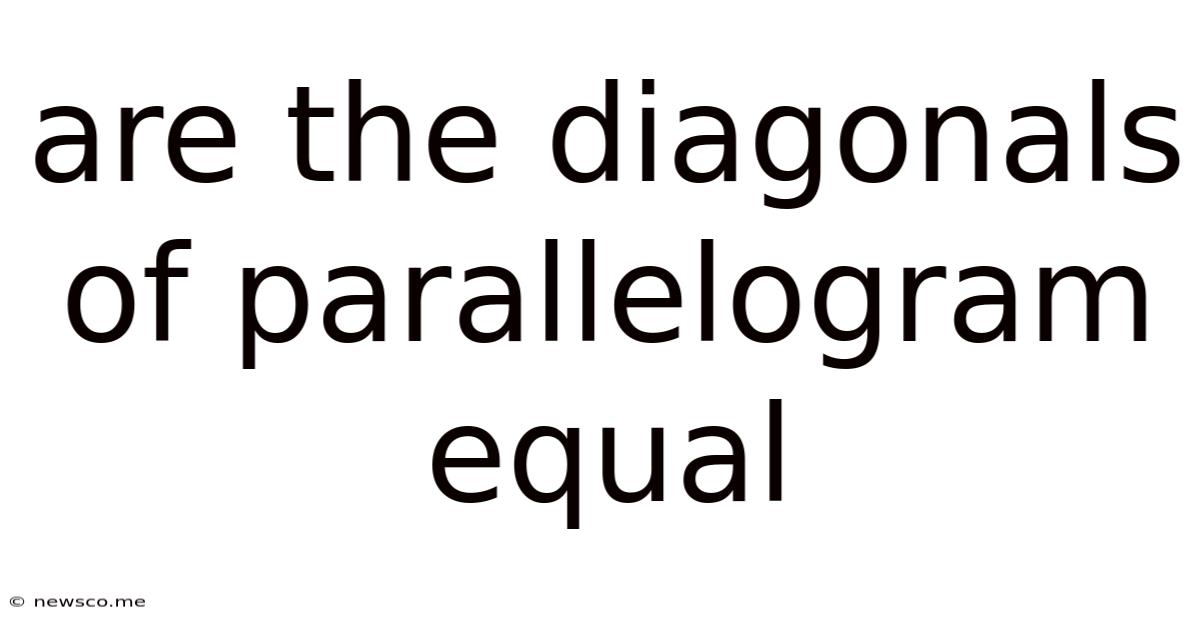Are The Diagonals Of Parallelogram Equal
News Co
Apr 25, 2025 · 5 min read

Table of Contents
Are the Diagonals of a Parallelogram Equal? Exploring the Properties of Parallelograms
The question, "Are the diagonals of a parallelogram equal?" is a fundamental one in geometry, leading us into a deeper understanding of the properties of parallelograms and their relationship to other quadrilaterals. The short answer is: no, the diagonals of a parallelogram are not generally equal in length. However, understanding when they are equal, and why, is crucial for mastering geometric concepts. This article delves into the properties of parallelograms, exploring the characteristics of their diagonals and contrasting them with other quadrilaterals like rectangles, rhombuses, and squares.
Understanding Parallelograms: A Foundation
Before we dissect the diagonals, let's solidify our understanding of parallelograms. A parallelogram is a quadrilateral (a four-sided polygon) with two pairs of parallel sides. This seemingly simple definition leads to several key properties:
- Opposite sides are equal: The lengths of opposite sides in a parallelogram are always equal. This is a direct consequence of the parallel sides.
- Opposite angles are equal: Similar to the sides, opposite angles within a parallelogram are congruent (equal in measure).
- Consecutive angles are supplementary: Consecutive angles (angles that share a side) add up to 180 degrees. This is a result of the parallel lines intersected by a transversal (the side of the parallelogram).
- Diagonals bisect each other: This is a crucial property. The diagonals of a parallelogram intersect at a point that divides each diagonal into two equal segments.
These properties form the bedrock of our exploration into parallelogram diagonals. We'll see how these properties play a role in determining whether the diagonals are equal or not.
Why Are Parallelogram Diagonals Not Always Equal?
The inherent nature of a parallelogram—simply having two pairs of parallel sides—doesn't guarantee equal diagonals. Consider a parallelogram that's been "squeezed" or "stretched." Imagine a rectangle; it's a special type of parallelogram. Now, imagine tilting the rectangle, maintaining the parallel sides, but changing the angles. This will result in a parallelogram where the diagonals are clearly different lengths.
The equality of diagonals is a consequence of additional constraints on the angles or sides of the parallelogram. Let's explore these constraints.
Special Cases: When Parallelogram Diagonals Are Equal
While generally unequal, a parallelogram's diagonals become equal under specific conditions, leading us to explore special types of parallelograms:
1. Rectangles
A rectangle is a parallelogram where all four angles are right angles (90 degrees). In a rectangle, the diagonals are indeed equal in length. This is easily proven using the Pythagorean theorem. Since opposite sides are equal and the angles are right angles, the diagonals form the hypotenuse of two congruent right-angled triangles. Therefore, the diagonals must be equal.
Proof using the Pythagorean Theorem:
Let's consider a rectangle ABCD, with vertices A, B, C, and D. Let the length of AB be 'a' and the length of BC be 'b'.
- Diagonal AC: By the Pythagorean theorem, AC² = a² + b²
- Diagonal BD: By the Pythagorean theorem, BD² = a² + b²
Since AC² = BD², we conclude that AC = BD. The diagonals are equal.
2. Squares
A square is a special case of both a rectangle and a rhombus. It inherits the equal diagonal property from the rectangle. In a square, all sides are equal, and all angles are 90 degrees. The diagonals are not only equal but also perpendicular bisectors of each other.
3. Are there any other parallelograms with equal diagonals?
No. The only parallelograms with equal diagonals are rectangles (including squares). Any parallelogram that is not a rectangle will have unequal diagonals. This is a direct consequence of the relationship between the angles and sides of the parallelogram and how those relationships affect the lengths of the diagonals.
Contrasting Parallelograms with Other Quadrilaterals
Understanding when parallelogram diagonals are equal requires comparing them to other quadrilaterals:
-
Rhombus: A rhombus is a parallelogram with all four sides equal in length. While its diagonals are perpendicular bisectors of each other, they are not necessarily equal unless the rhombus is also a square.
-
Trapezoid (Trapezium): A trapezoid has only one pair of parallel sides. Its diagonals are generally unequal and don't bisect each other. There are special cases of isosceles trapezoids where certain relationships exist, but they don't generally have equal diagonals.
-
Kite: A kite has two pairs of adjacent sides that are equal in length. The diagonals of a kite are perpendicular, but only one diagonal is bisected by the other. The diagonals are generally not equal.
Implications and Applications
The understanding of parallelogram diagonals extends beyond theoretical geometry. It has practical applications in:
-
Engineering: Analyzing structures and frameworks often involves understanding the properties of parallelograms and their diagonals to ensure stability and efficiency.
-
Computer Graphics: The principles of parallelograms are used extensively in computer graphics and animation for creating and manipulating shapes.
-
Physics: Many physical phenomena can be modeled using parallelogram properties, such as force resolution and vector addition.
Conclusion: A Deeper Understanding of Parallelogram Diagonals
The question of whether parallelogram diagonals are equal leads us on a journey through the fascinating world of geometric properties. While the general answer is no, understanding the special cases of rectangles and squares, and the contrast with other quadrilaterals, reveals a deeper appreciation for the interconnectedness of geometric concepts. The knowledge gained provides a strong foundation for further explorations in geometry and its diverse applications in various fields. Remembering the key distinctions—rectangles and squares possess equal diagonals, while other parallelograms generally do not—is essential for mastering geometric problem-solving.
Latest Posts
Related Post
Thank you for visiting our website which covers about Are The Diagonals Of Parallelogram Equal . We hope the information provided has been useful to you. Feel free to contact us if you have any questions or need further assistance. See you next time and don't miss to bookmark.